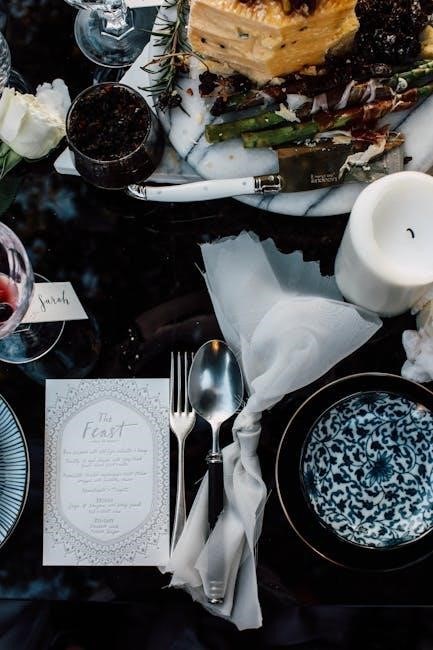Lighting is a crucial element in home design, enhancing functionality, aesthetics, and mood. It combines ambient, task, and accent layers to create a balanced, inviting space, essential for daily activities and ambiance.
1.1 Importance of Lighting in Home Design
Lighting plays a pivotal role in home design, influencing both functionality and aesthetics. It shapes the mood and ambiance of a space, making it feel welcoming and inviting. Proper lighting enhances productivity in task-oriented areas like kitchens and home offices while creating relaxation in living rooms and bedrooms. It also highlights architectural features and decor, adding visual interest. A well-designed lighting plan can make a room feel larger or cozier, depending on the desired effect. Ultimately, lighting is a powerful tool that balances practical needs with emotional appeal, transforming a house into a home.
1.2 Brief Overview of Lighting Types
Lighting is categorized into three primary types: ambient, task, and accent. Ambient lighting provides overall illumination, creating a uniform glow for general use. Task lighting targets specific areas, like reading or cooking, ensuring clarity and focus. Accent lighting highlights features, adding drama and visual appeal. Together, these layers create a balanced, functional, and aesthetically pleasing environment. Understanding these types helps in selecting fixtures that meet both practical and decorative needs, ensuring spaces are inviting, productive, and tailored to their purpose. A well-designed lighting plan combines these elements to enhance functionality, mood, and the beauty of a room.

Types of Lighting
Lighting is categorized into ambient, task, and accent types, each serving unique purposes. Together, they create a balanced, functional, and visually appealing environment tailored to specific needs and spaces.
2.1 Ambient Lighting
Ambient lighting provides overall illumination, creating a warm and welcoming atmosphere. It is designed to lighting an entire room or specific areas evenly, ensuring visibility and comfort. Common sources include ceiling fixtures, wall sconces, and recessed lighting. This type of lighting is essential for setting the base level of brightness, making spaces feel inviting and functional. It complements other lighting layers and is often the first step in a well-designed lighting plan. Proper ambient lighting enhances safety and creates a relaxing environment, making it a fundamental component of any room’s lighting scheme.
2.2 Task Lighting
Task lighting is focused illumination for specific activities, such as reading, cooking, or working. It provides bright, directed light to reduce eye strain and enhance productivity. Common sources include under-cabinet kitchen lights, desk lamps, and pendant lights over countertops. Unlike ambient lighting, task lighting targets particular areas, offering higher intensity where needed. It is essential for tasks requiring detail and precision, ensuring clarity and comfort. By integrating task lighting into your space, you create functional zones that support efficiency and focus, making it a vital component of a layered lighting design.
2.3 Accent Lighting
Accent lighting adds drama and visual interest by highlighting specific features, such as artwork, architectural details, or decorative elements. It creates focal points, drawing attention to what matters most in a room. This type of lighting is often decorative, using fixtures like chandeliers, wall sconces, or pendant lights to enhance aesthetics. Unlike ambient or task lighting, accent lighting is not the primary light source but serves to elevate the space’s style and mood.
By strategically placing accent lights, you can create a dynamic atmosphere, making a room feel more polished and inviting. It complements other lighting layers, adding depth and personality to your interior design.

Lighting Fixtures
Lighting fixtures are essential components that house light sources, providing both functionality and style. They come in various designs, from ceiling lights to pendant fixtures, enhancing interior spaces aesthetically.
3.1 Ceiling Lights
Ceiling lights are versatile fixtures mounted directly on the ceiling, providing ambient illumination. They are ideal for entryways and hallways, ensuring safe passage and creating a welcoming atmosphere. Available in various styles, from flush-mount to semi-flush designs, they suit different interior aesthetics. Many ceiling lights are energy-efficient and can be paired with dimmers for adjustable brightness. They offer a practical solution for general lighting needs while contributing to the overall decor of a room. Proper installation ensures both functionality and safety, making them a popular choice for homeowners seeking reliable lighting solutions.

3.2 Pendant Lights
Pendant lights are stylish fixtures that hang from the ceiling, often suspended by a cord, chain, or metal rod. They are commonly used in dining rooms, kitchens, and areas with high ceilings to add focal points. Available in a wide range of designs, pendant lights can complement various interior styles, from modern to traditional. They provide both task and ambient lighting, depending on their placement and bulb type. Pendant lights are versatile, offering options like adjustable heights and dimmable features. However, careful consideration of size and spacing is essential to avoid overwhelming a room. They are a popular choice for enhancing decor while providing functional illumination.

3;3 Recessed Lighting
Recessed lighting is a sleek, unobtrusive option where fixtures are installed into the ceiling, providing a clean, modern look. These lights are ideal for creating a minimalist aesthetic while offering focused illumination. Often used as downlights or potlights, they are versatile and suitable for any room. Recessed lights are great for highlighting specific areas, such as countertops or artwork, and can be adjusted to direct light where needed. However, overusing them can create a harsh environment, so balancing with other light sources is essential. They come in various finishes and styles to match different interior designs, making them a popular choice for enhancing both functionality and decor.
3.4 Track Lighting
Track lighting is a versatile and flexible lighting solution, offering multiple fixtures on a single track. It allows for directional adjustment, making it ideal for highlighting specific areas or objects. Track lights are commonly used in kitchens, living rooms, and hallways to provide task or accent lighting. They come in various styles, finishes, and configurations, making them adaptable to different interior designs. Track lighting can be surface-mounted or suspended, and its modular design enables easy customization. With options for dimming and energy-efficient LED bulbs, track lighting is both functional and stylish. However, the wide range of choices can be overwhelming, so consulting a lighting professional is recommended for the best results.

Light Bulbs and Color Temperature
LED, CFL, and incandescent bulbs offer varying energy efficiency and lifespan. Color temperature, measured in Kelvin, influences ambiance, with warm tones (2700K-3000K) for cozy spaces and cool tones (3500K-5000K) for task-focused areas.
4.1 LED, CFL, and Incandescent Bulbs
LED, CFL, and incandescent bulbs vary in efficiency and lifespan. LEDs are energy-efficient, long-lasting, and suitable for smart lighting systems. CFLs are cost-effective but contain mercury, requiring special disposal. Incandescent bulbs are affordable but less efficient, emitting heat. LEDs and CFLs are eco-friendly options, while incandescent bulbs are traditional choices. Consider bulb lifespan, energy consumption, and dimming compatibility when selecting. For eco-conscious homes, LEDs are recommended due to their durability and low energy use. Always check compatibility with fixtures and dimmers for optimal performance.
4.2 Understanding Color Temperature (Kelvin Scale)
Color temperature, measured in Kelvin (K), determines a light’s color appearance. Lower values (2700K-3000K) produce warm, yellowish tones, ideal for cozy spaces like bedrooms. Mid-range (3500K-4100K) offers bright, neutral light, suitable for kitchens and bathrooms. Higher values (5000K-6500K) mimic daylight, providing crisp, cool illumination for task-oriented areas. Choosing the right color temperature enhances ambiance and functionality, ensuring spaces feel inviting or energizing as needed. Soft white bulbs create relaxing atmospheres, while daylight options boost focus and clarity. Always select bulbs that align with your room’s purpose and desired mood for optimal lighting results.
Room-by-Room Lighting Guide
Each room has unique lighting needs based on its purpose. This guide provides tailored advice for spaces like living rooms, kitchens, and bedrooms to ensure optimal illumination and ambiance.

5.1 Living Room Lighting
The living room is a space for relaxation and entertainment, requiring a balanced lighting approach. Start with ambient lighting, such as ceiling fixtures or chandeliers, to create a welcoming atmosphere. Add task lighting, like table or floor lamps, for reading or conversing. Accent lighting, such as wall sconces or pendant lights, can highlight decorative elements. Layering these light types ensures functionality and style. Consider dimmers for adjustable brightness and portable options for flexibility. This combination creates a versatile and inviting space tailored to your lifestyle and decor.
5.2 Kitchen Lighting
Kitchen lighting must balance functionality and aesthetics to support cooking and socializing. Use task lighting, like under-cabinet LEDs, to illuminate countertops for food preparation. Ambient lighting, such as recessed lights, provides overall room illumination. Add accent lighting, like pendant lights above an island, to create visual interest. Consider layering these light types for optimal brightness and versatility. Dimmers can adjust light levels for different tasks, while portable options like plug-in fixtures offer additional flexibility. This layered approach ensures the kitchen is both functional and inviting, catering to various activities from cooking to entertaining.

5.3 Bedroom Lighting
Bedroom lighting should prioritize comfort and ambiance, creating a relaxing atmosphere. Use soft, warm lighting like table lamps or wall sconces for ambient illumination. Add task lighting, such as reading lights, for focused activities. Accent lighting, like a decorative chandelier or dimmed spotlights, can highlight specific features. Layering these light types ensures flexibility for relaxation, reading, or getting ready. Opt for warm-toned bulbs (2700K-3000K) to enhance coziness. Incorporate dimmers or smart lighting to adjust brightness and mood. This balanced approach transforms the bedroom into a serene retreat, blending functionality with a calming aesthetic.

Additional Lighting Controls
Enhance your lighting setup with dimmers and smart systems, allowing precise brightness and mood adjustments. Portable options like floor lamps provide flexibility, ensuring tailored illumination for any space.
6.1 Dimmers and Smart Lighting
Dimmers and smart lighting systems offer unparalleled control over your home’s illumination. Dimmers allow you to adjust brightness levels, creating the perfect ambiance while saving energy. Smart lighting takes it further, enabling remote control, voice commands, and automation through smart home systems. These technologies can be programmed to adjust based on time, occupancy, or activity, enhancing convenience and efficiency. Many smart bulbs are compatible with major platforms like Alexa or Google Home. However, ensure compatibility with your existing fixtures and bulbs, as not all dimmers work with LED or CFL options. Professional installation may be needed for advanced setups to avoid electrical issues.
6.2 Portable Lighting Options
Portable lighting offers flexibility and convenience, allowing you to move light sources as needed. Options include table lamps, floor lamps, and battery-operated fixtures, which are ideal for task lighting or adding ambiance. These lights are perfect for desks, bedside tables, or outdoor spaces, providing focused illumination without permanent installation. Many modern designs now feature energy-efficient LED bulbs and stylish finishes to match any decor. Portability ensures easy relocation, making them versatile for different settings. Additionally, some models offer dimming or color temperature adjustments, enhancing their functionality. Whether for practicality or aesthetics, portable lighting adds a dynamic layer to your home’s lighting scheme, ensuring adaptability and personalization.











































































